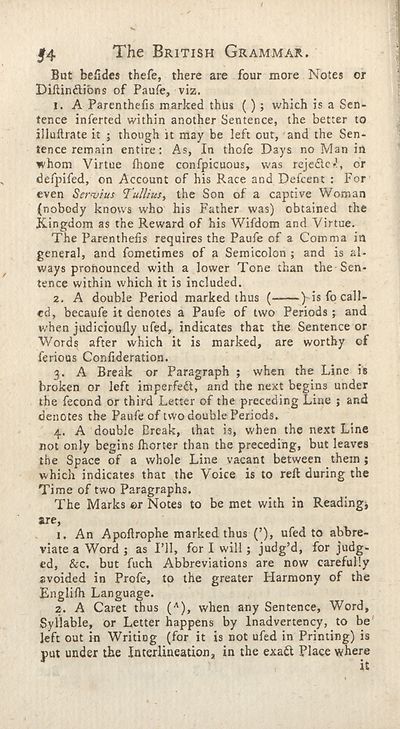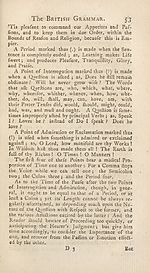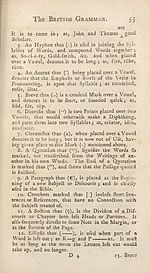Education > British grammar: or, an essay, in four parts, towards speaking and writing the English language grammatically, and inditing elegantly
(102)
Download files
Complete book:
Individual page:
Thumbnail gallery: Grid view | List view

J4 The British Grammar.
But befides thefe, there are four more Notes or
Diftindtibns of Paufe, viz.
1. A Parenthefis marked thus (); which is a Sen¬
tence inferred within another Sentence, the better to
illuftrate it ; though it may be left out, and the Sen¬
tence remain entire: As, In thofe Days no Man in
whom Virtue fhone confpicuous, was rejefte*!, or
defpifed, on Account of his Race and Defcent : For
even Servius Tullius, the Son of a captive Woman
(nobody knows who his Father was) obtained the
Kingdom as the Reward of his Wifdom and Virtue.
The Parenthefis requires the Paufe of a Comma in
general, and fometimes of a Semicolon ; and is al¬
ways pronounced with a lower Tone than the Sen¬
tence within which it is included.
2. A double Period marked thus ( )~isfo call¬
ed, becaufe it denotes a Paufe of two Periods ; and
when judicioufly ufed, indicates that the Sentence or
Words after which it is marked, are worthy of
ferious Confideration.
3. A Break or Paragraph ; when the Line is
broken or left imperfedt, and the next begins under
the fecond or third Letter of the preceding Line ; and
denotes the Paufe of two double Periods.
4. A double Creak, that is, when the next Line
not only begins fhorter than the preceding, but leaves
the Space of a whole Line vacant between them ;
which indicates that the Voice is to reft during the
Time of two Paragraphs.
The Marks ©r Notes to be met with in Readingi
are,
1. An Apoftrophe marked thus (’), ufed to abbre¬
viate a Word ; as I’ll, for I will; judg’d, for judg¬
ed, &c. but fuch Abbreviations are now carefully
avoided in Profe, to the greater Harmony of the
Englifti Language.
2. A Caret thus (A), when any Sentence, Word,
Syllable, or Letter happens by Inadvertency, to be
left out in Writing (for it is not ufed in Printing) is
put under the Interlineation, in the exadl Place where
it
But befides thefe, there are four more Notes or
Diftindtibns of Paufe, viz.
1. A Parenthefis marked thus (); which is a Sen¬
tence inferred within another Sentence, the better to
illuftrate it ; though it may be left out, and the Sen¬
tence remain entire: As, In thofe Days no Man in
whom Virtue fhone confpicuous, was rejefte*!, or
defpifed, on Account of his Race and Defcent : For
even Servius Tullius, the Son of a captive Woman
(nobody knows who his Father was) obtained the
Kingdom as the Reward of his Wifdom and Virtue.
The Parenthefis requires the Paufe of a Comma in
general, and fometimes of a Semicolon ; and is al¬
ways pronounced with a lower Tone than the Sen¬
tence within which it is included.
2. A double Period marked thus ( )~isfo call¬
ed, becaufe it denotes a Paufe of two Periods ; and
when judicioufly ufed, indicates that the Sentence or
Words after which it is marked, are worthy of
ferious Confideration.
3. A Break or Paragraph ; when the Line is
broken or left imperfedt, and the next begins under
the fecond or third Letter of the preceding Line ; and
denotes the Paufe of two double Periods.
4. A double Creak, that is, when the next Line
not only begins fhorter than the preceding, but leaves
the Space of a whole Line vacant between them ;
which indicates that the Voice is to reft during the
Time of two Paragraphs.
The Marks ©r Notes to be met with in Readingi
are,
1. An Apoftrophe marked thus (’), ufed to abbre¬
viate a Word ; as I’ll, for I will; judg’d, for judg¬
ed, &c. but fuch Abbreviations are now carefully
avoided in Profe, to the greater Harmony of the
Englifti Language.
2. A Caret thus (A), when any Sentence, Word,
Syllable, or Letter happens by Inadvertency, to be
left out in Writing (for it is not ufed in Printing) is
put under the Interlineation, in the exadl Place where
it
Set display mode to:
![]() Universal Viewer |
Universal Viewer | ![]() Mirador |
Large image | Transcription
Mirador |
Large image | Transcription
| Antiquarian books of Scotland > Education > British grammar: or, an essay, in four parts, towards speaking and writing the English language grammatically, and inditing elegantly > (102) |
|---|
| Permanent URL | https://digital.nls.uk/136145778 |
|---|
| Description | Thousands of printed books from the Antiquarian Books of Scotland collection which dates from 1641 to the 1980s. The collection consists of 14,800 books which were published in Scotland or have a Scottish connection, e.g. through the author, printer or owner. Subjects covered include sport, education, diseases, adventure, occupations, Jacobites, politics and religion. Among the 29 languages represented are English, Gaelic, Italian, French, Russian and Swedish. |
|---|

